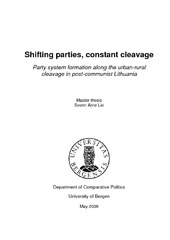Shifting parties, constant cleavage. Party system formation along the urban-rural cleavage in post-communist Lithuania
Master thesis
Permanent lenke
https://hdl.handle.net/1956/1906Utgivelsesdato
2006Metadata
Vis full innførselSamlinger
Sammendrag
When studying the party system formation in post-communist Lithuania, the WesternEuropean theoretical framework is a useful, although not sufficient tool to understand thisprocess. Weak alignments between voters and parties and unstable party systems have made itdifficult to apply the Western European theoretical framework because it prerequisites a highdegree of party institutionalisation. In addition to unstable electoral support for the establishedparties, new parties successfully emerge, but disappear, then change name, splinter and mergewith other parties.This thesis introduces the Reversed cleavage model, which is an attempt to study cleavages ina post-communist setting, exemplified with the urban-rural cleavage in Lithuania. Instead offocusing upon continuous representation of political parties, the Reversed cleavage modelapplies cleavage continuity as a point of departure. The unstable party system in Lithuania isthereby not related to voters’ missing perception of cleavages, but to the parties’ inability toestablish long-lasting alignments with the electorate. Party system formation along the urbanruralcleavage in post-communist Lithuania, is explained by shifting parties and constantcleavage.
Utgiver
The University of BergenOpphavsrett
The authorCopyright the author. All rights reserved
